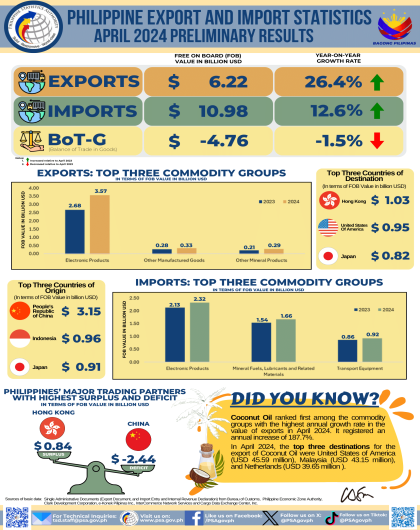Highlights of the Philippine Export and Import Statistics April 2024 (Preliminary)
January to August total trade stands at $47.910 billion
Total external trade in goods for January to August 2003 amounted to $47.910 billion or 3.2 percent higher than $46.446 billion during the same period a year ago. The bill for foreign-made merchandise increased by 6.1 percent to $24.908 billion from $23.479 billion. Likewise, exports registered a year-on-year growth rate of 0.2 percent to an aggregate dollar revenue of $23.002 billion from $22.967 billion a year earlier. Balance of trade deficit for the Philippines reached $1.905 billion compared to last years value which stood at $513 million.
Figure 1A. Philippine Trade Performance in January - August : 2002 and 2003
(F.O.B. Value in Million US Dollar)
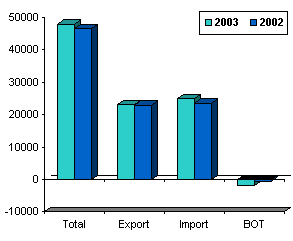
Figure 1B. Philippine Trade Performance: August: 2002 and 2003
(F.O.B. Value in Million US Dollar)
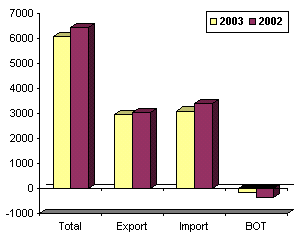
August imports decline by 8.5 percent
Total merchandise trade for August 2003 decreased by 5.5 percent to $6.072 billion from $6.425 billion during the same period last year. Dollar-inflow generated by exports amounted to $2.967 billion, or 2.1 percent lower than last years $3.032 billion. Likewise, expenditures for imported goods dropped by 8.5 percent to $3.105 billion from $3.393 billion. The BOT-G deficit for the Philippines was registered at $138 million, compared to last years figure at $361 million.
Electronic products account for 47.5 percent of import bill
Accounting for 47.5 percent of the total aggregate import bill, payments for electronic productsamounted to $1.475 billion or 14.9 percent lower than last year's $1.733 billion. Compared to the previous month, dollar-outflow reduced by 3.3 percent from $1.526 billion.
Purchases of mineral fuels, lubricants and related materials ranked second with 10.3 percent share. Payments made at $320.51 million, recorded a 38.7 percent increase over the previous level which stood at $231.15 million.
Industrial machinery and equipment, the third top import reported purchases worth $140.06 million, or a 14.7 percent decline from $164.17 million last year.
Transport equipment accounting for 3.2 percent of the total import bill, ranked fourth as payments amounted to $100.23 million, down by 2.9 percent from last year's $103.26 million.
Telecommunication equipment and electrical machinery, contributing 2.5 percent to the total bill, was RPs fifth top import for the month with payments placed at $76.95 million or 16.5 percent higher than last years $66.01 million.
Expenditures for iron and steel, with a 2.3 percent share to the aggregate bill, fell by 37.7 percent to $72.32 million from $116.12 million in August 2002.
Rounding up the list of the top imports for August 2003 were: textile yarn, fabrics, made-up articles and related products, $64.88 million; plastics in primary and non-primary forms,$64.29 million; cereals and cereal preparation, $56.56 million; and organic and inorganic chemical, $53.12 million.
Aggregate payment for the countrys top ten imports for August 2003 amounted to $2.424 billion or 78.1 percent of the total bill.
Figure 2. Philippine Top Imports in August 2002 and 2003
(F.O.B. Value in Million US Dollar)
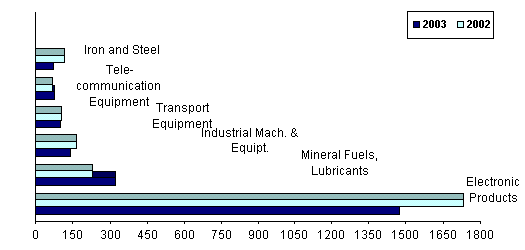
Capital goods account for 40.4 percent of the total import bill
Capital goods comprising 40.4 percent of the aggregate bill went down by 1.9 percent year-on-year to $1.255 billion from $1.280 billion. The biggest share went to telecommunication equipment and electrical machinery with a 23.0 percent share of the total and valued at $715.37 million.
Payments for raw materials and intermediate goods consisting of unprocessed raw materials and semi-processed raw materials accounted for 37.5 percent of the aggregate bill, as importation declined by 23.7 percent to $1.164 billion from last years reported figure at $1.525 billion.
Expenditures for mineral fuels, lubricants and related materials gained by 38.7 percent to $320.51 million from $231.15 million during the same period last year.
Purchases of consumer goods valued at $243.07 million, registered a 2.4 percent increase from $237.34 million in August 2002, while special transactions climbed by 2.0 percent to $122.38 million from $119.94 million.
Figure 3. Philippine Imports by Major Type of Goods in August: 2002 and 2003
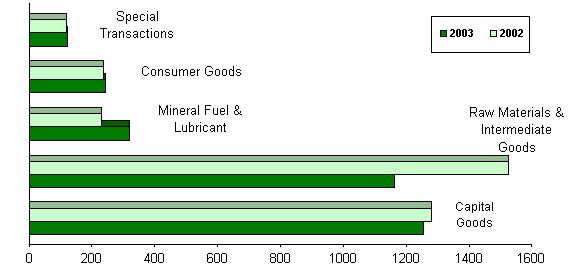
U.S. Corners 20.5 percent of august import bill
Imports from United States accounting for 20.5 percent of the total import bill, went down by 16.5 percent to $635.75 million from $761.52 million during the same period a year earlier. On the other hand, exports to US, amounted to $617.33 million yielding a two-way trade value of $1.253 billion and a trade deficit for RP placed at $18.42 million.
Japan, the countrys second biggest source of imports with a 19.6 percent share, reported shipments valued at $608.20 million against exports amounting to $461.34 million. Total trade amounted to $1.070 billion while the trade deficit for the Philippines was registered at $146.86 million.
Singapore, followed as RPs third biggest source of imports. With payments worth $219.52 million, imports from Singapore grew by 7.8 percent from $203.59 million while revenue from RPs exports reached $203.55 million resulting to a total trade value of $423.07 million and a $15.97 million deficit for RP.
Other major sources of imports for the month of August were: Republic of Korea, $171.99 million;Peoples Republic of China, $147.28 million; Taiwan, $144.93 million; Thailand, $131.75 million; Hong Kong, $120.29 million; Malaysia, $115.08 million; and Saudi Arabia, $114.04 million.
Payments for imports from the top ten sources for the month amounted to $2.409 billion or 77.6 percent of the total.
Figure 4. Philippine Imports by Country in August: 2003
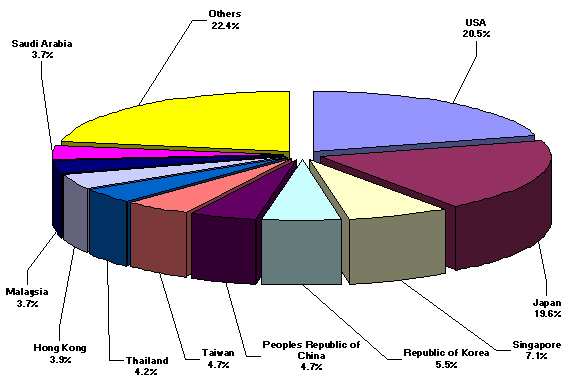
As of press time 111 out of 62,093 export documents and 57 out of 71,240 import documents are still expected from the ports.
Source: National Statistics Office
Manila, Philippines

